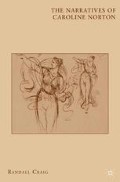Abstract
Norton’s readers from the 1830s and 1840s would surely have recognized her hand in the novels of the 1860s. Lost and Saved adapts numerous aspects of her first long poem, The Sorrows of Rosalie, and Old Sir Douglas returns to the familiar Scottish setting and symbolic landscape of pastoral north vs. urban south that features prominently in both The Wife and Stuart of Dunleath. Recurring themes, tropes, and modes, however, cannot disguise significant changes and evolving styles. Most notably, Norton introduces sensational plots and villains that accentuate the moral vision of melodrama—a change attributable in part to public taste. A survey of new fiction in 1863 concluded that a “book without a murder, a divorce, a seduction, or a bigamy, is not apparently considered worth either writing or reading.… [A] tale must needs be full of horror, excitement, and crime.”3 Norton’s shift in mode also reflects “an impatience of old restraints,” personal as well as artistic, and a search for a form that will enable her to combine more effectively different voices—plaintive and passionate, satirical and sentimental—within a single work.
The “sensation novel” of our time, however extravagant and unnatural, yet is a sign of the times—the evidence of a certain turn of thought and action, of an impatience of old restraints, and a craving for some fundamental change in the working of society. 1
“Our Female Sensation Novelists”
Of all the personages who figure in history, in poetry, in art, Mary Magdalene is at once the most unreal and the most real:—the most unreal if we attempt to fix her identity, which has been a subject of dispute for ages: the most real, if we consider her as having been, for ages, recognised and accepted in every Christian heart as the empersonation of the penitent sinner absolved through faith and love.2
Anna Jameson, Sacred and Legendary Art
Access this chapter
Tax calculation will be finalised at checkout
Purchases are for personal use only
Preview
Unable to display preview. Download preview PDF.
Notes
Barabara Z. Thaden discusses Frank’s ambiguous legal status in The Maternal Voice in Victorian Fiction (New York and London: Garland, 1997), 80.
On seamstresses and lace menders, see Helena Michie, The Flesh Made Word: Female Figures and Women’s Bodies (New York: Oxford University Press, 1987), 56, and
Deborah Anna Logan, Fallenness in Victorian Women’s Writing: Marry, Stitch, Die, or Do Worse (Columbia: University of Missouri Press, 1998), 32–35.
James Fitzjames Stephen, “Anti-Respectability,” The Cornhill Magazine 8 (September 1863), 282.
Norton’s heroine can be linked to Magdalene Vanstone in Wilkie Collins’s No Name. See Winfred Hughes, The Maniac in the Cellar: Sensation Novels of the 1860s (Princeton: Princeton University Press, 1980), 30–31.
See Jennifer DeVere Brody, Impossible Purities: Blackness, Femininity, and Victorian Culture (Durham and London: Duke University Press, 1998), 27–45.
Norton shared the view of Tennyson’s speaker about Nicholas I. See Otto Hans Rauchbauer, “Some Unrecorded Letters by Caroline Norton,” Notes and Queries 17 (September 1970), 338.
Copyright information
© 2009 Randall Craig
About this chapter
Cite this chapter
Craig, R. (2009). “Strange Unstable World”: Structure and Synthesis in the Final Narratives. In: The Narratives of Caroline Norton. Palgrave Macmillan, New York. https://doi.org/10.1057/9780230620414_3
Download citation
DOI: https://doi.org/10.1057/9780230620414_3
Publisher Name: Palgrave Macmillan, New York
Print ISBN: 978-1-349-37686-5
Online ISBN: 978-0-230-62041-4
eBook Packages: Palgrave Literature & Performing Arts CollectionLiterature, Cultural and Media Studies (R0)

